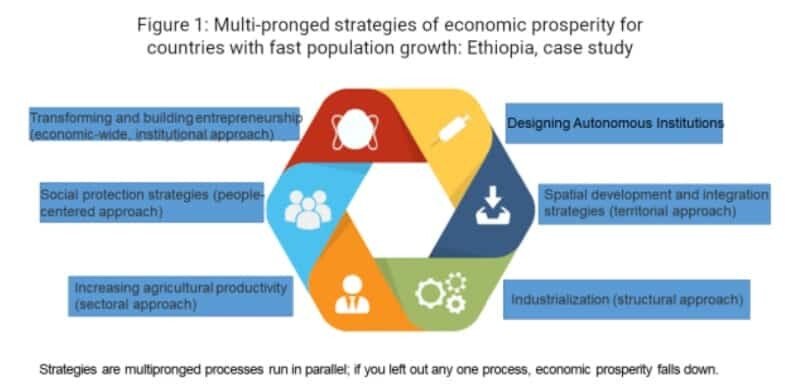
Tsegaye Tegenu, PhD
2022-08-24
On August 3, 2022, The Ethiopian Government held its annual meeting to review the macroeconomic performance of the country. The session led by the Prime Minster assessed the country’s economic journey and performance in terms of GDP growth and other macro-economic variables such as inflation, employment creation, export and investment promotion.
Despite higher inflation, incessant conflicts unfavorable to business, practice of corruption, global recessions, and rapid population growth, which all have negative relationship with economic growth, the Prime Minster declared that the country’s economy grew by 6,6%. That was consider as miracle and gave the credit to the government plan and effort.
Has the Ethiopian economy really grown as claimed by the government? There is a phrase which says, “beauty is in the eye of the beholder”, that means people can have differing opinions on what is beautiful. Do the criteria and information used by the government reflect the annual progress of the economy? How is the annual progress of the Ethiopian economy reviewed and measured? What does the statistics look like? How is the macroeconomy performance measured and conceptualized?
Questions regarding the statistics include: is the Government cooking up economic growth data? How is the government growth data collected? Is it transparent? Who has collected it? Is the estimation done by an independent body and global experts? Is there an exaggeration or underestimation?
Often Governments are accused of fudging data to fit planned targets. If the economic growth claim of the Government is based on cooked up data to give flavor to the annual plan, it will have a result opposite to what was planned. Under current conditions where the purchasing power shows almost no growth compared to inflation, how can we say that there is economic prosperity? Has the Government considered the existing discrepancy between the claimed growth figure and the purchasing power of the workers and families?
The skills and integrity of the statistics matter particularly in country where there is rapid population growth. In my opinion, in a country like Ethiopia macro-economic progress should be measured in terms of GDP per capita (which focuses on standard of living), not on GDP growth (which shows total economic activity of the country). In a country where there is rapid population growth, increases in GDP do not necessarily result in an improvement in the standard of living. The ministerial meeting did not say anything about the level of goods and services that individual Ethiopians can purchase or gain access to. Why the Government felt discomfort in calculating economic growth in terms of GDP per capita? That is because it has direct relationship to employment creation and inflation rate. In other words, knowingly or not, the Government avoids discussing solutions to chronic problems of the macroeconomy.
The problem is not only on criteria used to measure the annual progress of the economy. The brief made by the Prime Minster also shows the growth conceptualization of the government and strategies used to promote economic growth of the country. The Prime Minster mentioned the contribution of export, foreign direct investment and remittance in the annual progress and appreciated the continued role of these growth factors.
Theory and evidence show that economic growth led by input increase alone is not sustainable in the long run. History of developed economies shows that, continued economic growth is a result of productivity increase and not only input factor growth. On the contrary, the Ethiopian Government thinks to increase economic growth by continued mobilization of resources (increasing inputs of investment, infrastructure, trade and education). The Prime Minister thinks that GDP fluctuates over time (just like the business cycle model of growth) and during the phase of decrease in GDP, the country must use all its potential resources to increase output. The Prime Minster time and again advocates factor input-driven growth (incremental changes) rather than appreciating the need for economic structural transformation (systematic changes) and strategies of productivity increase. Had there been a plan of structural transformation, the discussion would have focused on the number and size of manufacturing industries established in small and medium size towns.
Currently there are 84 towns with a population of 20,000-200,000, and the current internal labor migration trend is towards these towns. In these urban centers the federal/and or regional government must lay the foundation of large-scale chemical and agricultural machinery manufacturing industries, instead of focusing on medium and small-scale enterprises (MSEs). Thereafter, in a second phase of structural transformation, the focus should be on developing of small-scale enterprise in small towns (such as establishment of oil mills, soap manufactures and textile factories). There are 353 small towns with a population 5000-19999, providing mostly non-tradable services to the hinterlands. As I see it the Government economic growth and development plan does not focus on strategies of structural and spatial transformation in the country (see figure one).

The macroeconomic committee of the Government did not discuss policies of promoting manufacturing sector and increasing industry-level productivity. The number and type of manufacturing industries in the country are limited and those that are available are working under capacity. However, there is no discussion of strategies in expanding manufacturing industries in medium and small towns and no declared policy of increasing their productivity level.
For the country, structural transformation and productivity driven economy is not a choice but a necessity. Due to rapid labor force growth, unemployment and under employment, it is time to move the focus to structural transformation and labor productivity growth. In the context of present-day Ethiopia, what must come first is structural transformation and not input factor growth as conceptualized and explained by the incumbent Government.
From my perspective and measurement criteria, I find it hard to accept Government claim of economic growth and prosperity in Ethiopia. The Government must know that there are people who have different criteria of measurement and conceptualization of sustained economic growth in Ethiopia. Because they are silent, it does not mean that they are ignorant and incapable of assessing government’s economic performance. It is not necessary to lecture as if there is only one accepted economic growth idea and path in the country.
The problem with Governments in Ethiopia is that they don’t listen to advice that are contrary to their views, perceptions, and beliefs. They think that they have monopoly on the truth. The Government of Haile Selassie did not listen to the advice of changing absolute monarchy rule. He was later overthrown by radicals. The next government that held the office, Derg regime, was advised by its military generals to negotiate with the rebels (ELF and TPLF) and solve the internal civil war through dialogue. Instead, the leader Mengistu Hailemariam arrested the generals and established a triangular command over the military, which consequently led to its downfall. The following EPRDF government was advised to install good governance, fair and inclusive economic growth. It did not listen and led to its dissolution.
The prosperity party, which aspires to start afresh, should now that Ethiopia is still trapped in underdevelopment and conflict. If you find yourself in a hole, the first law is Stop Digging. The government must stop its old input-growth thinking habit and strategy as the principal way of disentangling from the underdevelopment trap. Using ad hoc, fragmented, and patched up economic policy interventions such as service sector and trade-led growth, digs the hole deeper. It is structural and spatial transformation and rising output per worker (productivity growth) which increases employment and incomes of Ethiopian workers and their families. Not to remain trapped deep into the hole, the government must listen to other’s advice as to where to go next.
Further References
“What Does the Ethiopian Economy Want”: industrialization-led structural transformation”
How to create jobs quickly for all young people of Ethiopia
Ethiopia’s Economic Prosperity Vision-Strategy: Challenges of Old and New Recommendations
Reflection on the Ten Year National Economic Plan
Ethiopia’s Economy Needs Strategies and New Policy Design
China’s Pathways to Economic Self-Reliance: Lessons for Ethiopia

Something else escaped your attention:
What do you think of the PM’s assertion that forex earnings from all sources for the 2021-22 fiscal year reached a whopping $20 billion–roughly double the average inflows for the past few years? Unbelievable!